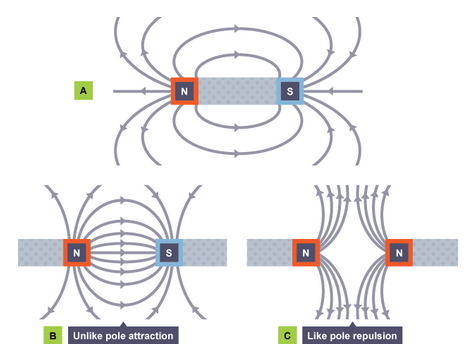
Unlike poles _________ while like poles __________ each other.
A. Attract, attract
B. Repel, repel
C. Repel, attract
D. Attract, repel
Answer
583.5k+ views
Hint: It is a well known fact that opposite poles attract each other just like opposite charges attract each other.
Complete step by step answer:
Magnetic pole is the region of a magnet where the magnetic field is strongest. A bar magnet suspended in Earth's magnetic field orients itself along the north–south direction. The pole pointing towards the north is called the north pole, while the one seeking south is called the south pole. The orientation of any magnetic dipole (unlike electrostatics, magnetic monopoles don't exist) is along the magnetic lines of force.
The attraction and repulsion of poles can be understood using magnetic lines of force and their properties. It is known to us that the lines of force never intersect each other. As such say when poles are brought together, the line of force or the flux lines move and bend away from each other. When they are brought too close, the lines avoid intersecting each

and bend so much away that it puts constraint to the motion of either poles and results in repelling each other. However, when opposite poles are brought together, the lines join each other, moving from one pole to the other, further aiding in bringing them closer.
Therefore, unlike poles attract while poles repel each other.
Hence, the correct option is D.
Note: It can also be explained using the idea that opposite poles when brought together cancel each other’s magnetic field, and in doing so also reduces the potential energy of the system bringing them close to a stable equilibrium. However, like poles, their fields add up, increasing the potential energy of the system, moving them further away from stable equilibrium.
Complete step by step answer:
Magnetic pole is the region of a magnet where the magnetic field is strongest. A bar magnet suspended in Earth's magnetic field orients itself along the north–south direction. The pole pointing towards the north is called the north pole, while the one seeking south is called the south pole. The orientation of any magnetic dipole (unlike electrostatics, magnetic monopoles don't exist) is along the magnetic lines of force.
The attraction and repulsion of poles can be understood using magnetic lines of force and their properties. It is known to us that the lines of force never intersect each other. As such say when poles are brought together, the line of force or the flux lines move and bend away from each other. When they are brought too close, the lines avoid intersecting each

and bend so much away that it puts constraint to the motion of either poles and results in repelling each other. However, when opposite poles are brought together, the lines join each other, moving from one pole to the other, further aiding in bringing them closer.
Therefore, unlike poles attract while poles repel each other.
Hence, the correct option is D.
Note: It can also be explained using the idea that opposite poles when brought together cancel each other’s magnetic field, and in doing so also reduces the potential energy of the system bringing them close to a stable equilibrium. However, like poles, their fields add up, increasing the potential energy of the system, moving them further away from stable equilibrium.
Recently Updated Pages
Master Class 12 Business Studies: Engaging Questions & Answers for Success

Master Class 12 Economics: Engaging Questions & Answers for Success

Master Class 12 English: Engaging Questions & Answers for Success

Master Class 12 Maths: Engaging Questions & Answers for Success

Master Class 12 Social Science: Engaging Questions & Answers for Success

Master Class 12 Chemistry: Engaging Questions & Answers for Success

Trending doubts
Which places in India experience sunrise first and class 9 social science CBSE

Fill the blanks with the suitable prepositions 1 The class 9 english CBSE

Write the 6 fundamental rights of India and explain in detail

Difference Between Plant Cell and Animal Cell

What is pollution? How many types of pollution? Define it

What is the full form of pH?




